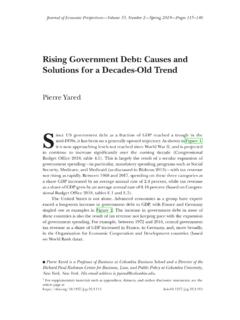Transcription of Automated and Autonomous Driving - Stanford University
1 Automated and Autonomous DrivingRegulation under uncertaintyCorporate Partnership Board ReportCorporate Partnership BoardCPBA utomated and Autonomous DrivingRegulation under uncertaintyCorporate Partnership Board ReportAbout the International Transport Forum The International Transport Forum at the OECD is an intergovernmental organisation with 54 member countries. It acts as a think tank for transport policy and organises the Annual Summit of transport ministers. ITF is the only global body that covers all transport modes. ITF works for transport policies that improve peoples lives. Our mission is to foster a deeper understanding of the role of transport in economic growth, environmental sustainability and social inclusion and to raise the public profile of transport policy.
2 ITF organises global dialogue for better transport. We act as a platform for discussion and pre-negotiation of policy issues across all transport modes. We analyse trends, share knowledge and promote exchange among transport decision makers and civil society. Our member countries are: Albania, Armenia, Australia, Austria, Azerbaijan, Belarus, Belgium, Bosnia and Herzegovina, Bulgaria, Canada, Chile, China (People s Republic of), Croatia, Czech Republic, Denmark, Estonia, Finland, France, Former Yugoslav Republic of Macedonia, Georgia, Germany, Greece, Hungary, Iceland, India, Ireland, Italy, Japan, Korea, Latvia, Liechtenstein, Lithuania, Luxembourg, Malta, Mexico, Republic of Moldova, Montenegro, Netherlands, New Zealand, Norway, Poland, Portugal, Romania, Russian Federation, Serbia, Slovak Republic, Slovenia, Spain, Sweden, Switzerland, Turkey, Ukraine, United Kingdom and United States.
3 Disclaimer This report is published under the responsibility of the Secretary-General of the International Transport Forum. Funding for this work has been provided by the ITF Corporate Partnership Board. This report has not been subject to the scrutiny of International Transport Forum member countries. The opinions expressed and arguments employed herein do not necessarily reflect the official views of member countries. This document and any map included herein are without prejudice to the status of or sovereignty over any territory, to the delimitation of international frontiers and boundaries and to the name of any territory, city or area.
4 TABLE OF CONTENTS 3 Automated AND Autonomous Driving : REGULATION UNDER UNCERTAINTY - OECD/ITF 2015 Table of contents Executive summary .. 5 Introduction .. 9 1. Automated and Autonomous Driving : Technologies, contexts and capabilities .. 11 Technologies and infrastructures .. 11 Capabilities and contexts .. 13 2. Use cases, business cases and potential deployment pathways .. 17 Products and services .. 18 Deployment paths and technologies .. 18 3. Regulatory environment .. 25 Types of regulation .. 25 Regulatory approaches .. 25 Regulatory considerations and policy choices .. 26 Key challenges .. 28 Proposals for different automation strategies.
5 29 Annex: Current regulatory frameworks for the testing of Autonomous vehicles .. 30 Bibliography .. 33 Figures 1. Technologies that allow vehicles to sense, plan and act in response to the dynamic Driving environment .. 11 2. Levels of Driving automation according to the Society of Automotive Engineers .. 14 3. Transition from high to full Driving automation across different contexts .. 16 4. Urban mobility pathway from human to fully Automated Driving .. 21 5. Automated private vehicle pathway from human to fully Automated Driving .. 22 6. Heavy-duty truck automation pathway from human to fully Automated Driving .. 23 7. Types of regulation for Automated Driving .
6 25 EXECUTIVE SUMMARY 5 Automated AND Autonomous Driving : REGULATION UNDER UNCERTAINTY - OECD/ITF 2015 Executive summary Many cars sold today are already capable of some level of Automated operation, and prototype cars capable of Driving autonomously have been - and continue to be - tested on public roads in Europe, Japan and the United States. These technologies have arrived rapidly on the market and their future deployment is expected to accelerate. Autonomous Driving promises many benefits: improved safety, reduced congestion and lower stress for car occupants, among others. Authorities will have to adapt existing rules and create new ones in order to ensure the full compatibility of these vehicles with the public s expectations regarding safety, legal responsibility and privacy.
7 This report explores the strategic issues that will have to be considered by authorities as more fully Automated and ultimately Autonomous vehicles arrive on our streets and roads. It was drafted on the basis of expert input and discussions amongst project partners in addition to a review of relevant published research and position papers. What we found Automated Driving technologies are mostly mature and some Autonomous Driving is here already Most of the core technologies required for fully Autonomous Driving are available today, many are mature and some are already being deployed in commercially available vehicles. Self- Driving cars seem a near-term possibility but their range of capabilities is unclear Many major car manufacturers and several technology firms have announced the commercial production of highly Automated vehicles starting in 2017.
8 Many observers expect there to be a wide range of such models on the market by 2030, and some of these may be self- Driving . It is not clear at present, however, to what extent these vehicles will be capable of self- Driving in all circumstances. Road safety is expected to improve with vehicle automation. But this effect remains untested at a large scale and may not be immediate or linear Most crashes involve human error. If greater Autonomous operation reduces or eliminates these errors, then benefits for road safety may be substantial. However, most Driving involves no crashes. The real safety test for Autonomous cars will be how well they can replicate the crash-free performance of human drivers.
9 While results from early prototypes are promising, new types of crashes may emerge as Autonomous technologies become more common for instance crashes resulting from the car handing control back to the driver or from mixing Autonomous and conventional vehicles. There are many possible technological configurations for Autonomous Driving The move towards Autonomous Driving may involve different technological configurations. Some rely on greater connectivity between cars and between cars and infrastructure. These entail the development of common communication protocols, encrypted security standards and investment in new types of infrastructure or upgrading those which currently exist.
10 Others rely more on vehicle-embarked sensor platforms and require little infrastructure investment. Both models require precise digital representations of their environment, including high definition maps. There are two incremental paths towards full automation The first path involves gradually improving the automation in conventional vehicles so that human drivers can shift more of the dynamic Driving task to these systems. The second path involves deploying vehicles without a human driver in limited contexts and then gradually expanding the range and conditions of their use. The first path is generally embraced by traditional car manufacturers and the second by new entrants.






